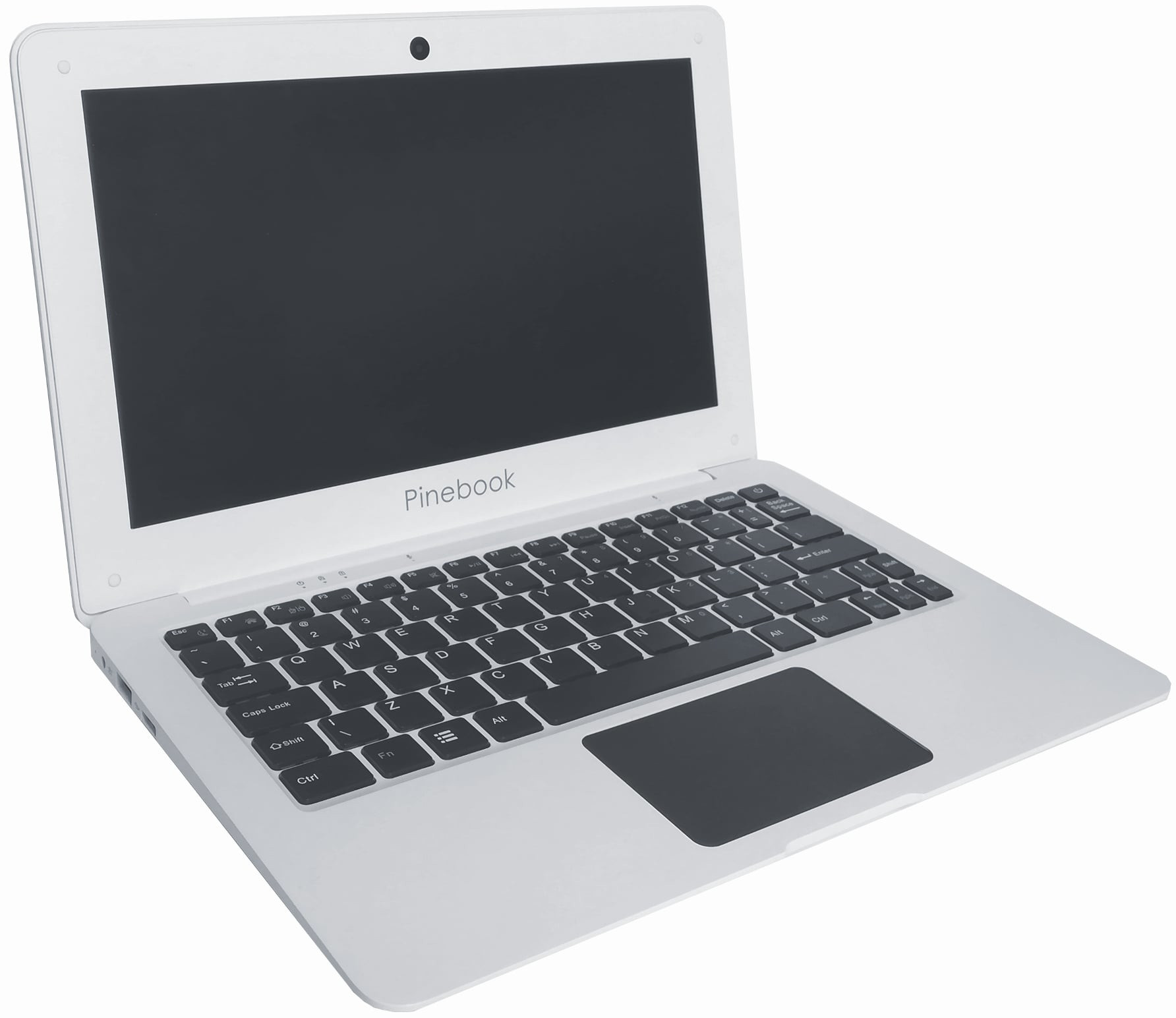Pinebook full documentation

The Pinebook
The Pinebook is an 11.6″ or 11.6″ with 1080P IPS panel or 14″ notebook powered by the same quad-core ARM Cortex A53 64-Bit Processor used in our popular PINE A64 Single Board Computer. It is very lightweight, hackable and comes equipped with a full-sized keyboard and large multi-touch trackpad. It runs numerous mainline Linux distributions as well as *BSD and Android.
Variants
The following variants exist of the Pinebook:
- Pinebook 11.6″
- Pinebook 11.6″ 1080p
- Pinebook 14″
More information can be found on the sunxi wiki.
Software
This page contains a list of all available releases and tools for the Pinebook.
Linux
AOSC

AOSC OS is a general purpose Linux distribution that strives to simplify user experience and improve free and open source software for day-to-day productivity. To learn more about AOSC, please visit the official AOSC website.
Download:
| Default credentials | |
|---|---|
aosc | anthon |
Armbian

Armbian is a Linux distribution designed for ARM boards. They are usually Debian or Ubuntu flavored. To find out more about Armbian and available download options please visit the Armbian ROCK64 site.
| Compatibility | ||
|---|---|---|
| Pinebook 11.6″ | Pinebook 11.6" 1080p | Pinebook 14″ |
| ✅ | ✅ | ✅ |
Download:
| Default credentials | |
|---|---|
root | 1234 |
Debian
Debian is an operating system and a distribution of Free Software. The forum thread for release can be found here.
| Compatibility | ||
|---|---|---|
| Pinebook 11.6″ | Pinebook 11.6" 1080p | Pinebook 14″ |
| ✅ | ✅ | ✅ |
Download:
- Debian 11 Bullseye (recommended)
- Debian 12 Bookworm
- Daily netboot images
Installation:
- The Readme provides info about concatenating firmware.pinebook.img.gz + partition.img.gz to create a bootable installer image.
Notes:
- Installer offers automatic partitioning and full-disk encryption (LUKS), but only manual partitioning with a single ext4 partition has been confirmed to work.
- Bootloader must be installed separately after installation, before rebooting.
- WiFi driver kernel module must be provided during installation, or a USB network adapter used. (Android USB tethering works, with network driver
rndis_host). - See also: Debian Netboot installer on the 1080P Pinebook under Software releases
DietPi

DietPi is a lightweight yet easy to setup and feature-rich Linux distribution, based on Debian. To find out more about DietPi, please visit the official documentation. Discuss the ROCK64 build on the PINE64 forum thread.
Download:
- Debian 11 Bullseye (supports the microSD card and eMMC, 4GB or more)
- Debian 12 Bookworm (supports the microSD card and eMMC, 4GB or more)
| Default credentials | |
|---|---|
root | dietpi |
Kali

Kali Linux is an Advanced Penetration Testing Linux distribution used for Penetration Testing, Ethical Hacking and network security assessments.
| Compatibility | ||
|---|---|---|
| Pinebook 11.6″ | Pinebook 11.6" 1080p | Pinebook 14″ |
| ✅ | ✅ | ✅ |
Download:
| Default credentials | |
|---|---|
kali | kali |
Slackware

Slackware is a very old, interesting, convenient and easy distribution. Visit the project’s website here (https://fail.pp.ua). You can follow the ongoing discussion about Slackware on the PINE64 forum (https://forum.pine64.org/showthread.php?tid=9439).
| Compatibility | ||
|---|---|---|
| Pinebook 11.6″ | Pinebook 11.6" 1080p | Pinebook 14″ |
| ❓ | ✅ | ❓ |
Download:
| Default credentials | |
|---|---|
| Root user | |
root/password |
BSD Image Releases
NetBSD

NetBSD community build. To learn more about NetBSD please visit the NetBSD main page.
Download:
| Compatibility | ||
|---|---|---|
| Pinebook 11.6″ | Pinebook 11.6" 1080p | Pinebook 14″ |
| ✅ | ❓ | ❓ |
Notes:
- Instructions concerning enabling SSH can be found here
| Default credentials | |
|---|---|
root (SSH and TTY) | [none] |
OpenBSD

OpenBSD 6.6-snapshot, Community Build Image (FVWM2 WM). To learn more about OpenBSD please visit OpenBSD main page. If you need more information please ping: https://forum.pine64.org/member.php?action=profile&uid=12423.
Download:
| Default credentials | |
|---|---|
pine64 (SSH and TTY) | pine64 |
root | pine64 |
Android Image Releases

Android 7.x
Android 7.1 Community Build Image [microSD Boot] by ayufan. It only works on the 14.1" and 11.6" Pinebook, not applicable to 1080P 11.6’ Pinebook. Special thanks to ayufan, Icenowy, lennyraposo, longsleep, lukasz, tkaiser, Xalius and PINE64 community contributors. Please use good random IO access performance microSD card such as the Samsung EVO when trying out Android 7.1.
Download:
- ayufan’s GitHub, look for android-7.1-pine-a64-pinebook-x.x.x-xx.img.gz (for microSD cards with 4GB or more)
Notes:
- Please allows some time (around 5 minutes) for the initialization process on the first boot.
Android 6.x eMMC
Android 6.0.1
Rootable build, online update (OTA) only works when the build is not rooted. The LCD resolution is 1366 x 768.
| Compatibility | ||
|---|---|---|
| Pinebook 11.6″ | Pinebook 11.6" 1080p | Pinebook 14″ |
| ✅ | ❌ | ✅ |
Download:
- Rooted image (for microSD cards with 4GB or more) from pine64.org (776MB, MD5 of the Gzip file C99BF459C6724BA73F12C532E87A8BA5, build 20170605)
Notes:
- microSD to eMMC
Android 6.0.1
Rootable build. The LCD resolution is 1920 x 1080.
| Compatibility | ||
|---|---|---|
| Pinebook 11.6″ | Pinebook 11.6" 1080p | Pinebook 14″ |
| ❌ | ✅ | ❌ |
Download:
- Rooted image (for microSD cards with 4GB or more) from pine64.org (595MB, MD5 of the Gzip file E433A148CEBD743EADE6CAA765331A4B, build 20181001)
Notes:
- microSD to eMMC
Android 6.0.1
Rootable build. The LCD resolution is 1920 x 1080. Please use an high performance microSD card for Android. Please ignore the warning message regarding an corrupted SD on the home screen in the upper left corner.
| Compatibility | ||
|---|---|---|
| Pinebook 11.6″ | Pinebook 11.6" 1080p | Pinebook 14″ |
| ❌ | ✅ | ❌ |
Download:
- For 8GB microSD cards from pine64.org (553MB, MD5 of the Gzip file CD27DF6083E6A4A5E7C8B986EB92FAA7, build 20181001)
- For 16GB microSD cards from pine64.org (703MB, MD5 of the Gzip file 1376AAE8382E96FD7B45B0998A5CD6E9, build 20181001)
- For 32GB microSD cards from pine64.org (867MB, MD5 of the Gzip file B54E7F323B316750654E385B078AEC58, build 20181001)
- For 64GB microSD cards from pine64.org (734MB, MD5 of the Gzip file C8DBC6293EB51E58F91E27364C8C587D, build 20181001)
Notes:
- microSD boot
/e/

/e/OS community build. To learn more about /e/OS, please visit the official website. Please check out this article on the Pinebook /e/ build. For a thread discussion please visit the PINE64 forum
| Compatibility | ||
|---|---|---|
| Pinebook 11.6″ | Pinebook 11.6" 1080p | Pinebook 14″ |
| ❌ | ✅ | ❌ |
Download:
- Direct download from pine64.org (685MB, MD5 of the GZip file: 4DC46A4E3ED2B47F4830E96DFCBBC6D8)
Linux BSP SDK
Download:
- Linux BSP 4.0 from pine64.org (4.67GB, MD5 of the TAR-GZip file 802D7C92D27177CBD17567359F9845A7)
- Linux BSP 3.0 from pine64.org (4.18GB, MD5 of the TAR-GZip file 898ACF446851DF3BE7B643F62CE3CE84)
- Linux BSP 2.0, kernel v3.10 (including GPL compliance header) from pine64.org (6.41GB, MD5 of the TAR-GZip file 2EE11C9AED246C17995493F213A6A6DA)
Android SDK
Android Marshmallow (v6.0)
Download:
- Direct Download from pine64.org (15.92GB, MD5 of the Zip file 12362D0B63EBF29FC363A50A942346D5)
| Compatibility | ||
|---|---|---|
| Pinebook 11.6″ | Pinebook 11.6" 1080p | Pinebook 14″ |
| ✅ | ❓ | ❓ |
Other resources
- Mali_Driver
- Allwinner PhoenixCard Bootable SD-Card Creator
- Allwinner DragonFace V2.2.5 software that will let you edit and modify A64 Android Build PhoenixCard image (Direct download at Mega)
FAQ and tips
Key left of Z ( \ | )
How to map the key next to Z to the symbols on \ and | (rather than <>) ?
Choose the alternative international US keyboard layout and variant. The name will depend on you desktop environment:
- English (US, alt. intl.)
- English (US, international AltGr Unicode combining, alternative)
- English (US, alternative international)
To set the keyboard layout and variant in the terminal for X-Windows use:
setxkbmap -layout us -variant altgr-intl
The Archlinux Wiki has some good help if you need to tweak your layout further [https://wiki.archlinux.org/index.php/Xorg/Keyboard_configuration#Setting_keyboard_layout]
Key between Fn and Alt (Menu)
How to map the key between Fn and Alt to SUPER / META ?
The initial setup in many desktop environments maps the key between Fn and Alt to MENU. Although the menu key can be useful as well (e.g. spell correction in the browser) many desktop environments and window manager use the Super key for many other useful functions. And users are probably more used to have the META key near Ctrl and Alt.
In X-windows the following command maps the key between Fn and Alt to META and the Caps-Lock key to MENU.
setxkbmap -option caps:menu,altwin:alt_super_win
Set display brightness in the terminal
To set the display brightness in the terminal use xbacklight (if available in your distro):
xbacklight -setXX
XX is the percentage (%) of brightness. E.g. for 70% brightness
xbacklight -set70
If you use LXQt you can also use:
pkexec lxqt-backlight_backend --inc
pkexec lxqt-backlight_backend --dec
For an alternative solution please see the scripts discussed in this thread: [https://forum.pine64.org/showthread.php?tid=5062]
Get battery % in CLI
As ACPI is not compatible with ARM, to gather the % battery this can be used:
cat /sys/class/power_supply/battery/capacity
Firefox font size
How to get a useful font size with firefox ?
To have every web page displayed in a larger more readable font size type about:config in the search bar and confirm on the first page that you want to make changes. Then search for this parameter:
layout.css.devPixelsPerPx
and modify the value (right click) to something between 1.2 to 1.5 depending on your preferences.
In addition to that you can set in Preferences -> General -> Fonts & Color -> Advanced Minimum font size to 16
Disable wireless power management
If having issues with wifi connectivity, try to disable power management in the 8723cs module options, adding rtw_power_mgnt=0 in /etc/modprobe.d/8723cs.conf
options 8723cs rtw_initmac=00:ba:ch:16:85:46 rtw_power_mgnt=0
Touchpad acceleration and scroll direction
To set touchpad parameters from the cli you can use the command xinput. To use it correctly you first need to determine the device id / name for your touchpad. To do so, use:
xinput list
You are looking for a line like this:
HAILUCK CO.,LTD USB KEYBOARD Mouse id=7 [slave pointer (2)]
With the device id = 7 found you can list the parameters that can be set with xinput.
xinput list-props 7
The result looks similar to this:
device 'HAILUCK CO.,LTD USB KEYBOARD Mouse':
...
libinput Natural Scrolling Enabled (256): 0
...
libinput Accel Speed (265): 0.000000
...
To change the parameter use xinput set-prop
To set reverse scrolling for the touchpad use this command
xinput set-prop 7 'libinput Natural Scrolling Enabled' 1
To set mouse speed
xinput set-prop 7 'libinput Accel Speed' 0.95
Check different numbers for 0.95 to meet your needs.
For more details on xinput and mouse speed also see the Archlinux Wiki [https://wiki.archlinux.org/index.php/Mouse_acceleration#Using_xinput]
Prolong battery life
How to reduce the max voltage the battery is charged to:
$ cd /sys/class/power_supply/axp20x-battery
$ cat voltage_max_design
4200000
Check the factory value on your device, and record it if it is different. The value depends on the battery installed. You can reduce it to 4.1 V by running the following Linux command as root:
$ echo 4100000 > voltage_max_design
If you are fully charged and on AC, the battery will start discharging until it reaches 4.1 V. This will be about 98% capacity on my device. This prolongs the battery life when you don’t need the extra few minutes of offline power. The Linux driver will not let you set the maximum voltage to a value smaller than 4.1V (as of Linux kernel 6.3.8).
The setting seems to be retained across reboots.
Service guides
These are instruction guides for the disassembly:
11.6″ Pinebook:
14″ Pinebook:
Further information
Specifications
The Pinebook is based on the Allwinner A64.
Dimensions:
- 299mm x 200mm x 12mm (WxDxH - 11″ Pinebook); 329mm x 220mm x 12mm (WxDxH - 14″ Pinebook)
Weight:
- 1.04Kg (11″ Pinebook); 1.26Kg (14″ Pinebook)
Input Power:
- DC 5V @ 3A
CPU Architecture:
- Quad-core ARM Cortex-A53 Processor@1152Mhz
- A power-efficient ARM v8 architecture
- 64 and 32bit execution states for scalable high performance
- Support NEON Advanced SIMD (Single Instruction Multiple Data) instruction for acceleration of media and signal processing function
- Support Large Physical Address Extensions(LPAE)
- VFPv4 Floating Point Unit
- 32KB L1 Instruction cache and 32KB L1 Data cache
- 512KB L2 cache
GPU Architecture:
- ARM Mali400MP2 Dual-core GPU
- Support OpenGL ES 2.0 and OpenVG 1.1 standard
- Open source driver
System Memory:
- System RAM Memory: 2GB
- Storage Memory: 16GB eMMC module, can be upgrade to 32GB or 64GB eMMC module
Battery:
- Lithium Polymer Battery (10,000 mAh; 9,600 mAh in later batches)
Video:
- Mini Digital Video Port (Type A - mini)
Audio:
- 3.5mm stereo earphone/microphone plug
Network:
- WiFi 802.11 b/g/n with Bluetooth 4.0
- 10/100 Mbps USB Ethernet Dongle (Optional)
Storage:
- microSD - bootable, support SDHC and SDXC, storage up to 256GB
- USB - 2 USB2.0 Host port
Expansion Ports:
- mini Digital Video port
- microSD card port - support SD, SDHC, SDXC uo to 256GB
- 2x USB 2.0 port
- earphone plug with UART console mux circuit
Datasheets
Allwinner A64 SoC:
- Allwinner A64 SoC Brief Introduction
- Allwinner A64 SoC Data Sheet V1.1 (Official Released Version)
- Allwinner A64 SoC User Manual V1.0 (Official Release Version)
X-Powers AXP803 PMU (Power Management Unit):
LPDDR3:
eMMC:
- PINE64 eMMC module schematic
- PINE64 USB adapter for eMMC module V2 schematic
- PINE64 USB adapter for eMMC module PCB in JPEG
- 16GB Foresee eMMC Datasheet
- 32GB/64GB/128GB SanDisk eMMC Datasheet
SPI NOR flash:
WiFi/BT module:
LCD Panel:
- 1920x1080 1080P 11.6″ IPS LCD Panel datasheet
- 1366x768 11.6″ TFT LCD Panel datasheet
- 1366x768 14″ TFT LCD Panel datasheet
Touchpad:
Camera sensor:
Lithium battery:
- 10000 mAH Lithium Battery Specification for 11.6″ model
- 10000 mAH Lithium Battery Specification for 14″ model
Schematics and certifications
Mainboard schematics:
Daughter Board schematics:
Serial Console Earphone Jack pinout:
Certifications:
- Pinebook FCC Certificate
- Pinebook FCC ID-Spread Spectrum Transmitter Certificate
- Pinebook FCC ID-Digital Transmission System Certificate
- Pinebook CE Certificate
- Pinebook RoHS Certificate


